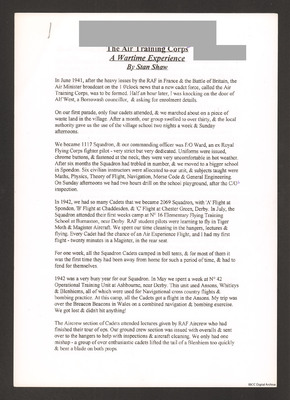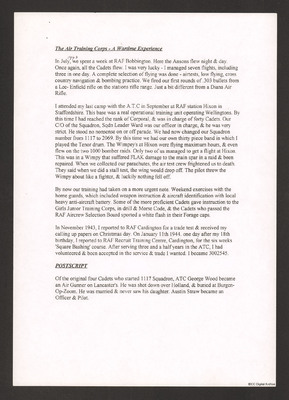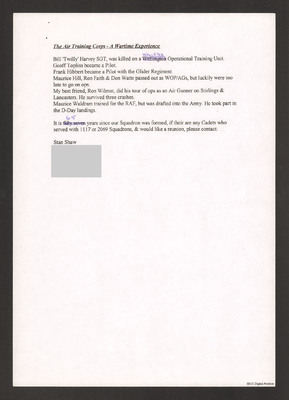The Air Training Corps: A Wartime Experience
Title
The Air Training Corps: A Wartime Experience
Description
His story begins in June 1941 when the Air Minister broadcast that a new cadet force was to be set up. Stan joined immediately. Initially they marched then received training in relevant subjects - Maths, Physics, Theory of Flight, Navigation, Morse and General Engineering. Flights in Magisters and Ansons followed. Camps at training airfields were organised, allowing further flights including Wellingtons. He served 3 1/2 years in the ATC then joined up. He lists the fates of his fellow cadets.
Creator
Spatial Coverage
Coverage
Language
Format
Three typed sheets
Publisher
Rights
This content is available under a CC BY-NC 4.0 International license (Creative Commons Attribution-NonCommercial 4.0). It has been published ‘as is’ and may contain inaccuracies or culturally inappropriate references that do not necessarily reflect the official policy or position of the University of Lincoln or the International Bomber Command Centre. For more information, visit https://creativecommons.org/licenses/by-nc/4.0/ and https://ibccdigitalarchive.lincoln.ac.uk/omeka/legal.
Contributor
Identifier
MShawSR3002545-160211-100001, MShawSR3002545-160211-100002, MShawSR3002545-160211-100003
Transcription
[underlined] The Air Training Corps
A Wartime Experience
By Stan Shaw [/underlined]
In June 1941, after the heavy losses by the RAF in France & the Battle of Britain, the Air Minister broadcast on the 1 O’clock news that a new cadet force, called the Air Training Corps, was to be formed. Half an hour later, I was knocking on the door of Alf West, a Borrowash councillor, & asking for enrolment details.
On our first parade, only four cadets attended, & we marched about on a piece of waste land in the village. After a month, our group swelled to over thirty, & the local authority gave us the use of the village school two nights a week & Sunday afternoons.
We became 1117 Squadron, & our commanding officer was F/O Ward, an ex Royal Flying Corps fighter pilot – very strict but very dedicated. Uniforms were issued, chrome buttons, & fastened at the neck, they were very uncomfortable in hot weather. After six months the Squadron had trebled in number, & we moved to a bigger school in Spondon. Six civilian instructors were allocated to our unit, & subjects taught were Maths, Physics, Theory of Flight, Navigation, Morse Code & General Engineering. On Sunday afternoons we had two hours drill on the school playground, after the C/Os inspection.
In 1942, we had so many Cadets that we became 2069 Squadron, with ‘A’ Flight at Spondon, ‘B’ Flight at Chaddesden, & ‘C’ Flight at Chester Green, Derby. In July, the Squadron attended their first weeks camp at No 16 Elementary Flying Training School at Burnaston, near Derby. RAF student pilots were learning to fly in Tiger Moth & Magister Aircraft. We spent our time cleaning in the hangers, lectures & flying. Every Cadet had the chance of an Air Experience Flight, and I had my first flight – twenty minutes in a Magister, in the rear seat.
For one week, all the Squadron Cadets camped in bell tents, & for most of them it was the first time they had been away from home for such a period of time, & had to fend for themselves.
1942 was a very busy year for our Squadron. In May we spent a week at No 42 Operational Training Unit at Ashbourne, near Derby. This unit used Ansons, Whitleys & Blenhiems, [sic] all of which were used for Navigational cross country flights & bombing practice. At this camp, all the Cadets got a flight in the Ansons. My trip was over the Breacon [sic] Beacons in Wales on a combined navigation & bombing exercise. We got lost & didn’t hit anything!
The Aircrew section of Cadets attended lectures given by RAF Aircrew who had finished their tour of ops. Our ground crew section was issued with overalls & sent over to the hangers to help with inspections & aircraft cleaning. We only had one mishap – a group of over enthusiastic cadets lifted the tail of a Blenhiem [sic] too quickly & bent a blade on both props.
[page break]
[underlined] The Air Training Corps – A Wartime Experience [/underlined]
In July, [inserted] 1943 [/inserted] we spent a week at RAF Bobbington. Here the Ansons flew night & day. Once again, all the Cadets flew. I was very lucky – I managed seven flights, including three in one day. A complete selection of flying was done – airtests, low flying, cross country navigation & bombing practice. We fired our first rounds of .303 bullets from a Lee-Enfield rifle on the stations rifle range. Just a bit different from a Diana Air Rifle.
I attended my last camp with the A.T.C. in September at RAF station Hixon in Staffordshire. This base was a real operational training unit operating Wellingtons. By this time I had reached the rank of Corporal, & was in charge of forty Cadets. Our C/O of the Squadron, Sqdn Leader Ward was our officer in charge, & he was very strict. He stood no nonsense on or off parade. We had now changed our Squadron number from 1117 to 2069. By this time we had our own thirty piece band in which I played the Tenor drum. The Wimpey’s at Hixon were flying maximum hours, & even flew on the two 1000 bomber raids. Only two of us managed to get a flight at Hixon. This was in a Wimpy that suffered FLAK damage to the main spar in a raid & been repaired. When we collected our parachutes, the air test crew frightened us to death. They said when we did a stall test, the wing would drop off. The pilot threw the Wimpy about like a fighter, & luckily nothing fell off.
By now our training had taken on a more urgent note. Weekend exercises with the home guards, which included weapon instruction & aircraft identification with local heavy anti-aircraft battery. Some of the more proficient Cadets gave instruction to the Girls Junior Training Corps, in drill & Morse Code, & the Cadets who passed the RAF Aircrew Selection Board sported a white flash in their Forage caps.
In November 1943, I reported to RAF Cardington for a trade test & received my calling up papers on Christmas day. On January 11th 1944. one day after my 18th birthday, I reported to RAF Recruit Training Centre, Cardington, for the six weeks ‘Square Bashing’ course. After serving three and a half years in the ATC, I had volunteered & been accepted in the service & trade I wanted. I became 3002545.
[underlined] POSTSCRIPT [/underlined]
Of the original four Cadets who started 1117 Squadron, ATC George Wood became an Air Gunner on Lancaster’s. He was shot down over Holland, & buried at Burgen-Op-Zoom. He was married & never saw his daughter. Austin Straw became an Officer & Pilot.
[page break]
[underlined] The Air Training Corps – A Wartime Experience [/underlined]
Bill ‘Twilly’ Harvey SGT, was killed on a [deleted] Wellington [/deleted] [inserted] HALIFAX [/inserted] Operational Training Unit.
Geoff Topliss became a Pilot.
Frank Hibbert became a Pilot with the Glider Regiment.
Maurice Hill, Ron Faith & Don Watts passed out as WOP/AGs, but luckily were too late to go on ops.
My best friend, Ron Wilmot, did his tour of ops as an Air Gunner on Stirlings & Lancasters. He survived three crashes.
Maurice Waldram trained for the RAF, but was drafted into the Army. He took part in the D-Day landings.
It is [deleted] fifty seven [/deleted] [inserted] 65 [/inserted] years since our Squadron was formed, if their [sic] are any Cadets who served with 1117 or 2069 Squadrons, & would like a reunion, please contact:
Stan Shaw
A Wartime Experience
By Stan Shaw [/underlined]
In June 1941, after the heavy losses by the RAF in France & the Battle of Britain, the Air Minister broadcast on the 1 O’clock news that a new cadet force, called the Air Training Corps, was to be formed. Half an hour later, I was knocking on the door of Alf West, a Borrowash councillor, & asking for enrolment details.
On our first parade, only four cadets attended, & we marched about on a piece of waste land in the village. After a month, our group swelled to over thirty, & the local authority gave us the use of the village school two nights a week & Sunday afternoons.
We became 1117 Squadron, & our commanding officer was F/O Ward, an ex Royal Flying Corps fighter pilot – very strict but very dedicated. Uniforms were issued, chrome buttons, & fastened at the neck, they were very uncomfortable in hot weather. After six months the Squadron had trebled in number, & we moved to a bigger school in Spondon. Six civilian instructors were allocated to our unit, & subjects taught were Maths, Physics, Theory of Flight, Navigation, Morse Code & General Engineering. On Sunday afternoons we had two hours drill on the school playground, after the C/Os inspection.
In 1942, we had so many Cadets that we became 2069 Squadron, with ‘A’ Flight at Spondon, ‘B’ Flight at Chaddesden, & ‘C’ Flight at Chester Green, Derby. In July, the Squadron attended their first weeks camp at No 16 Elementary Flying Training School at Burnaston, near Derby. RAF student pilots were learning to fly in Tiger Moth & Magister Aircraft. We spent our time cleaning in the hangers, lectures & flying. Every Cadet had the chance of an Air Experience Flight, and I had my first flight – twenty minutes in a Magister, in the rear seat.
For one week, all the Squadron Cadets camped in bell tents, & for most of them it was the first time they had been away from home for such a period of time, & had to fend for themselves.
1942 was a very busy year for our Squadron. In May we spent a week at No 42 Operational Training Unit at Ashbourne, near Derby. This unit used Ansons, Whitleys & Blenhiems, [sic] all of which were used for Navigational cross country flights & bombing practice. At this camp, all the Cadets got a flight in the Ansons. My trip was over the Breacon [sic] Beacons in Wales on a combined navigation & bombing exercise. We got lost & didn’t hit anything!
The Aircrew section of Cadets attended lectures given by RAF Aircrew who had finished their tour of ops. Our ground crew section was issued with overalls & sent over to the hangers to help with inspections & aircraft cleaning. We only had one mishap – a group of over enthusiastic cadets lifted the tail of a Blenhiem [sic] too quickly & bent a blade on both props.
[page break]
[underlined] The Air Training Corps – A Wartime Experience [/underlined]
In July, [inserted] 1943 [/inserted] we spent a week at RAF Bobbington. Here the Ansons flew night & day. Once again, all the Cadets flew. I was very lucky – I managed seven flights, including three in one day. A complete selection of flying was done – airtests, low flying, cross country navigation & bombing practice. We fired our first rounds of .303 bullets from a Lee-Enfield rifle on the stations rifle range. Just a bit different from a Diana Air Rifle.
I attended my last camp with the A.T.C. in September at RAF station Hixon in Staffordshire. This base was a real operational training unit operating Wellingtons. By this time I had reached the rank of Corporal, & was in charge of forty Cadets. Our C/O of the Squadron, Sqdn Leader Ward was our officer in charge, & he was very strict. He stood no nonsense on or off parade. We had now changed our Squadron number from 1117 to 2069. By this time we had our own thirty piece band in which I played the Tenor drum. The Wimpey’s at Hixon were flying maximum hours, & even flew on the two 1000 bomber raids. Only two of us managed to get a flight at Hixon. This was in a Wimpy that suffered FLAK damage to the main spar in a raid & been repaired. When we collected our parachutes, the air test crew frightened us to death. They said when we did a stall test, the wing would drop off. The pilot threw the Wimpy about like a fighter, & luckily nothing fell off.
By now our training had taken on a more urgent note. Weekend exercises with the home guards, which included weapon instruction & aircraft identification with local heavy anti-aircraft battery. Some of the more proficient Cadets gave instruction to the Girls Junior Training Corps, in drill & Morse Code, & the Cadets who passed the RAF Aircrew Selection Board sported a white flash in their Forage caps.
In November 1943, I reported to RAF Cardington for a trade test & received my calling up papers on Christmas day. On January 11th 1944. one day after my 18th birthday, I reported to RAF Recruit Training Centre, Cardington, for the six weeks ‘Square Bashing’ course. After serving three and a half years in the ATC, I had volunteered & been accepted in the service & trade I wanted. I became 3002545.
[underlined] POSTSCRIPT [/underlined]
Of the original four Cadets who started 1117 Squadron, ATC George Wood became an Air Gunner on Lancaster’s. He was shot down over Holland, & buried at Burgen-Op-Zoom. He was married & never saw his daughter. Austin Straw became an Officer & Pilot.
[page break]
[underlined] The Air Training Corps – A Wartime Experience [/underlined]
Bill ‘Twilly’ Harvey SGT, was killed on a [deleted] Wellington [/deleted] [inserted] HALIFAX [/inserted] Operational Training Unit.
Geoff Topliss became a Pilot.
Frank Hibbert became a Pilot with the Glider Regiment.
Maurice Hill, Ron Faith & Don Watts passed out as WOP/AGs, but luckily were too late to go on ops.
My best friend, Ron Wilmot, did his tour of ops as an Air Gunner on Stirlings & Lancasters. He survived three crashes.
Maurice Waldram trained for the RAF, but was drafted into the Army. He took part in the D-Day landings.
It is [deleted] fifty seven [/deleted] [inserted] 65 [/inserted] years since our Squadron was formed, if their [sic] are any Cadets who served with 1117 or 2069 Squadrons, & would like a reunion, please contact:
Stan Shaw
Collection
Citation
Stan Shaw, “The Air Training Corps: A Wartime Experience,” IBCC Digital Archive, accessed July 27, 2024, https://ibccdigitalarchive.lincoln.ac.uk/omeka/collections/document/25819.
Item Relations
This item has no relations.



